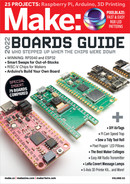
L
ast year we introduced the Best Maker Schools
list, a non-ranked survey of colleges that
offer maker programs and makerspaces for
students. Providing access to physical space and
tools is the most basic form of a makerspace, but
access to training and a diverse community of
makers are equally important.
Fortunately, the number of colleges and
universities with makerspaces continues to
grow, so rather than print the listing here in
the magazine, we’ve created a directory of Best
Maker Schools at make.co/maker-schools. (Soon
we might have a much shorter list of colleges and
universities that do not have a makerspace!)
For some time, we’ve heard that the
makerspace is one of the stops on the college
tour for prospective students, and surveys
indicate that a makerspace is a reason
for students to choose a school. Just as
important is that students are arriving on
campus understanding what they might do in
a makerspace. It is our hope that the growth
of makerspaces in higher education causes
high schools and middle schools to provide
makerspaces for their students.
One reason universities support makerspaces
is that they represent an opportunity for
interdisciplinary learning and collaboration
among students from different parts of the
university. Crossing outside of a field or meeting
others from a different discipline can spark new
ideas.Makerspaces have also become places to
promote the practice of innovation, serving as an
incubator for new projects that can lead to the
creation of new companies. A makerspace, like a
library, can be used for many different purposes,
including as a social space for students.
Large universities have managed to find
funding for makerspaces from alumni, and
some are housed in brand-new buildings.Larger
universities also have many makerspaces on
campus, which creates the need to standardize
training so that students can move from one
space to the next while also allowing spaces
to have their own characteristics and purpose.
The University of Wyoming, for example, has
started to manage a network of makerspaces in
universities, local libraries, and other locations
throughout the state.
One of the challenges faced by Fab Labs and
makerspaces was how to open the makerspace
to the local community. Some have addressed
this problem by partnering with outside
organizations who manage the space, balancing
the needs of students with those of a broader
community.Such collaborations also help
connect students to maker communities off
campus.
The value of a makerspace need not be
defined by its size, the extent of its tools, or
its budget.There are modest makerspaces in
small community colleges that also deserve
recognition.They reach many students who
may never have had the opportunity to create
something in a makerspace.
Earlier this year, I met students from Moorpark
College (pictured above), a community college in
California. Their makerspace is called MakeShop,
“a cross-disciplinary hub of entrepreneurship
run entirely by students under the guidance of
discipline faculty.”Mia had designed a red robot
toy.Angela had built a kit for kids to make an
animal design. Arylon had created a kiln furniture
stamp, a marking solution for the school’s
ceramics studio.
The best maker schools are those that
encourage more and more students to do real-
world work, develop useful skills, and gain
experience solving problems or creating products
that they care about.
25
make.co
Monash University, Timothy Hursley/Rural Studio, Aja Garrison/Phoenix Forge, Dale Dougherty
M83_024-27_MakerSchools_F1.indd 25M83_024-27_MakerSchools_F1.indd 25 10/10/22 11:57 AM10/10/22 11:57 AM
..................Content has been hidden....................
You can't read the all page of ebook, please click here login for view all page.
